How To Set Pickup Height On Guitar
Adjusting Strat Pickup Height
- Article #1742916
- Updated on Nov 6, 2019 at 2:43 PM

Overview
The proximity of your pickups to the strings has a significant effect on the overall tone of your Strat. Pickup height is often overlooked, as many guitar players will jump to replacing pickups before experimenting with what is already installed. Whether your dissatisfied with your tone, just looking to experiment, or you want to dial in Fender's exact specifications, it's always a good idea to try adjusting your pickup heights before swapping pickups. Fortunately, adjusting your Strat's pickup height is something that anyone can do with a bit of guidance. This article will provide you with just that.
1. How Pickups Work
2. Adjusting Your Pickup Height
3. Measuring Pickup Height
How Pickups Work
Before making an adjustment, it's good to know how your pickups are actually working in order to help you find the proper placement for them. The pickups in your Strat are basically small antennas that translate string vibration into an electrical signal. Inside your pickups are six magnets (pole pieces) wrapped in thousands of turns of copper wire. When the vibrating string is within the magnetic field of the guitar pickups, it disrupts the field, generating a small electric current. This small electric signal comes out of your guitar and into your amp, which is converted back into sound by the speaker.
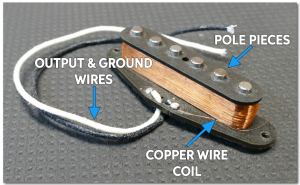
Knowing how pickups work provides insight into how to properly adjust them.
Generally, the closer your pickups are to the strings, the greater the treble response and overall output. Unfortunately, there is no one-size-fits-all answer to the question of how high your pickups should be set. So when it comes to your own guitar, some experimentation is often necessary to find the best sound for you.
Adjusting Your Pickup Height
Now that you know the basics of how your pickup is working inside your guitar, it's time to find a setting that works for you.
Each pickup is mounted onto the pickguard with a screw and spring on each side of the pickup. The screw head goes through the pickguard, passes through a spring, and threads into the ear of the pickup. Tightening the screw raises the height of the pickup, while loosening the screw will lower it into the body.
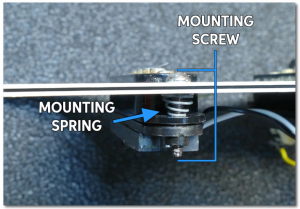
The screw and spring work together to properly set the pickup.
The Tape Trick
Before you start turning the screws on your guitar, we recommend placing some tape on the sides of each pickup and using a pen or pencil to mark the level of the pickguard on the tape. If you move your pickups around and decide that you don't like the results, you can easily bring them right back to where you started.
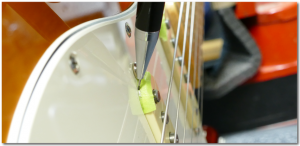
Mark the starting heights of the pickups on tape for future reference.
Having done this, grab an appropriately sized screwdriver and start making some adjustments. While you are doing this, it's a good idea to keep in mind the following:
Considerations
- It's possible for your pickups to be too close to your strings. In extreme cases, the pole pieces will touch the strings and prevent notes from ringing out. But even if they are not physically touching, the magnetic pull from the pickups can give you intonation problems and "warbly" tones (see audio example below).
- Use your ears! How your guitar sounds is the most important factor in determining where your pickups should be set. Additionally, it's possible for the outputs of each pickup to become unbalanced with each other. So as you are setting your heights, listen frequently to both tone and overall volume between settings. Hopefully, after taking some time to adjust your pickups, you've found a setting that sounds great for your guitar. If, however, you are having some trouble or would like a more methodical approach to pickup adjustment, read on for a more in-depth tutorial on how to make the most of your Strat pickups.
The Methodical Approach
In our methodical approach to pickup adjustment, we're going to measure and record the starting positions of our pickups rather than use the tape-and-pencil method. This will allow you to set your pickups to a standard height and to communicate your final measurements to others. This is essential if you decide to take your guitar to a tech for a repair or setup and want the same string-to-pickup spacing when you get your guitar back.
Measuring Your Pickup Height
The standard way to measure your pickup height is to fret the guitar at the highest fret and measure from the top of the pole piece to the bottom of the string. This will allow for proper string clearance on every fret and string. Measuring pickup height in relation to the open string may result in certain notes fretting out in the higher frets. This happens because as you fret higher up the neck, the strings may lower far enough to hit the pole pieces and stop vibrating. Here at Sweetwater, our techs measure in increments of 32nds or 64ths of an inch. Depending on what type of ruler you have, you may want to use a different unit of measurement.
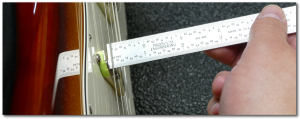
Precise pickup height measurements are crucial for proper string clearance.
Making the Adjustments
Once you've measured and recorded your starting heights, you will be ready to make some adjustments. So where to start? Our guitar techs here at Sweetwater recommend trying the following measurements as a good starting point for most Strat pickups. Remember, this is just a guideline. What should be the determining factor for your guitar's pickup height is what sounds preferable to your playing style.
Start by setting all of your guitar pickups to 3/32" (0.093", 2.38mm) on the bass side and 2/32" (1/16", 0.0625", 1.98mm) on the treble side. Remember, this is the space between the top of the pole piece and the bottom of the string, held down at the last fret. This should set your pickups at a reasonable "middle of the road" setting that should offer balanced output from each pickup.
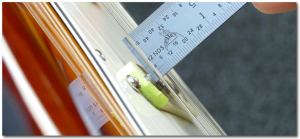
Set your pickups to 3/32 on the bass side to start and see how it sounds!
Once this is done, plug in your guitar and see how it sounds. Does it sound better or worse than it did with the pickups where you originally had them? Continue to make adjustments to your pickups until you've reached a desired tone.
As you do this, consider the following:
- The closer your pickups get to the strings, the more treble and overall output you will get from your pickups. However, the closer you get to the string, the more susceptible you are to excessive feedback, "warbly" notes, and intonation problems.
- The farther your pickups are from the strings, the more mellow the tone will be. Moving your pickups too far away may result in a weak output signal from your guitar.
As mentioned above, you'll want to be aware of the output balance between each pickup after making an adjustment. This is just as important as tone, in many cases. For example, let's say you've swapped the stock bridge pickup in your Strat for a Seymour Duncan Hot Rails (a high-output single coil–sized humbucker). If you position this at the same height as the original pickup, chances are your guitar will be significantly louder at the bridge position than at other pickup settings. If this is not desired, you will need to compensate for this difference in output by either lowering the hotter bridge pickup or raising the middle and neck pickups closer to the strings to match the output of the bridge. This is why you will commonly see pickups sold as sets, where the manufacturer selects a set of pickups that typically work well together, both in output and tone.
Conclusion
Once you've found a pickup placement that you are happy with, take one final check with your ruler and write the measurements down. This will come in handy later if you decide to change your guitar's action or have it set up. With action and other setup adjustments, your string-to-pickup distance can change. So having your preferred pickup placement measurements on hand will allow you to easily get your pickups back to where you want them.
This covers just about everything you need to know about adjusting your pickup height. Even though we mainly dealt with Strats in this article, you can take this information and apply it to just about any electric guitar. Remember: your ears are what should determine what's right for your guitar.
Trust your ears!
Helpful Links
How to Change Strings on a Bass
Guitar Setup: How do I measure the action on my electric guitar?
How To Setup Your Electric Guitar Part 1: Adjusting the Truss Rod
The Great Standby Switch Myth
Solving Guitar Noise, Buzz and Hum
When you need help, Sweetwater has the answers!
Our knowledge base contains over 28,000 expertly written tech articles that will give you answers and help you get the most out of your gear. Our pro musicians and gear experts update content daily to keep you informed and on your way. Best of all, it's totally FREE, and it's just another reason that you get more at Sweetwater.com.

- adjust
- change
- electric guitar
- height
- modify
- pickup
- pickup height
- strat
- strat pickup
- stratocaster
- tweak
- 60thStratPickup
- 60thStratStrap
- AffinityStrat
- Strat20RelBM
- Strat56HRDS
- Strat60HRSFG
- StratADHSHOpd1
- StratAMMSSB2U
- StratASRWSBLU
- Fender
- Fender Custom Shop
How To Set Pickup Height On Guitar
Source: https://www.sweetwater.com/sweetcare/articles/adjusting-strat-pickup-height/
Posted by: torresimpt1995.blogspot.com


0 Response to "How To Set Pickup Height On Guitar"
Post a Comment